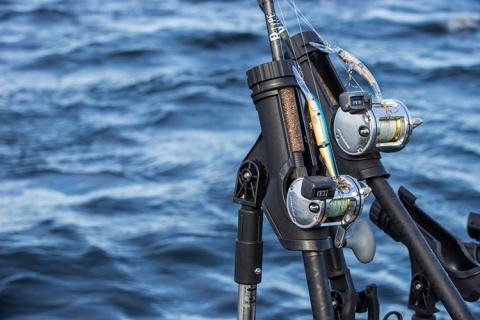
We were fishing together, yet we were fishing in two different boats. Neither of us wanted to fish from the back of another angler's boat — both of us wanted to fish from the bow. Our solution has always been to take two boats. Someone asked me one time why we took two boats. My answer was — because we can!
 |
| Considered to be one of the most important differences between casting reels is the number of bearings inside the reel. |
As we sat literally on top of a school of fish casting our lures, my buddy Don seemed to cast with an easy flow, never backlashing, and effortlessly casting longer distances than I did, even into the stiff breeze that was blowing.
My casts, on the other hand were shorter, required more effort, and ended up in some minor backlashes about half the time. I consider myself to be quite proficient with a baitcasting outfit, and while I blamed the backlashes on the wind, it frustrated me to watch Don out cast and out catch me that day. He had a definite advantage.
Answering my frustration, Don's advice was to buy "better gear." His equipment was top of the line — $300 rods and $200 reels. My tackle was in the range of $100 to $150 for the whole outfit. The difference in price and quality was why his equipment outperformed mine, according to Don.
Can your choice of rod and reel really make a difference in your casting ability? Is there a reason to buy the more expensive brands? To the average angler, the answer to those questions may be no, but to the serious fisherman, the guides and the professionals, the answer is a resounding "yes!"
Reels for the casting angler can range in price from ridiculously low to ridiculously high. Some of the price difference is determined as much by the brand name as anything, but there are some very important mechanical issues that separate premium priced reels.
Perhaps the most important difference among casting reels is the number of bearings inside the reel. The least expensive reels have no bearings and use brass sleeves and shims. The most expensive reels can have as many as 10 or 12 ball bearings, each serving a particular friction point on the reel.
On a given cast, line needs to leave the reel in a smooth, even flow. Ball bearings in the reel insure that this flow is uninterrupted. A cheaper reel that is still new will have these qualities, but it will deteriorate with usage over a short period of time.
The interesting part in all this is that the cheaper reels can and will be as smooth and quiet as the most expensive ones when first purchased. The milling of the sleeves and shims is such that little or no difference can be felt. But with usage over a relatively short period of time, the soft brass wears, and a reel that was once tight and quiet, is now loose and noisy.
Reels with significant bearing construction will last a lifetime with proper care, and they can remain tight and quiet. Don chose to invest in the more expensive tackle while I labored with more midrange equipment. The difference was telling on me this day.
 |
| Fast and super-fast tapered rods cost more to manufacture and therefore cost the angler more. |
The second advantage that Don had over me was his rod choice. My rods are okay — they come from a well-known brand and have served me well over the years. Don's rods are significantly different than mine. As I watched him set the hook and reel a fish to the boat, the top 20 percent of his rod tip was about all that was bending. His 7-foot rod has a super fast taper. That is, the tip is extremely flexible, while the remainder of the rod has a good backbone and bends only slightly.
My rods have a medium or at best a semi-fast taper. One or two of them have a slow taper. I have one with little or no taper that actually reacts like a broomstick!
The rod tip acts as a slingshot of sorts, adding a whip like action to the cast. The fast taper loads the rod on the back swing so that the cast will pull line from the reel in a controlled fashion.
Fast and super fast tapered rods cost more to manufacture, and that cost is passed to the angler. Many anglers shy from these more expensive rods, only to have casting issues down the road.
Why is all this important? It's simple: Don chose the right combination of reel and rod, and his casting woes have been for the most part completely solved.
Does that mean that every fisherman needs to run out and mortgage his home for better tackle? No, but it does mean that an initial investment can serve well over the years.
If you fish a lot — a whole lot — I believe it is a mistake to buy cheap tackle. It will work well for a short while and then begin to cause problems.
On the other hand, if you fish only occasionally, the less expensive tackle can and will serve you well over the years. A cost/benefit analysis says go with the cheaper equipment!
Will the more expensive reels and rods help me to cast better? Absolutely! Are they necessary? Perhaps not; there has to be a break point at which the cost of the tackle is more than your usage demands. You need to analyze your own situation, and decide how much money to invest in your tackle. The right investment can last for years. The wrong one can have you back in short order looking for more tackle.
- 5767 views

